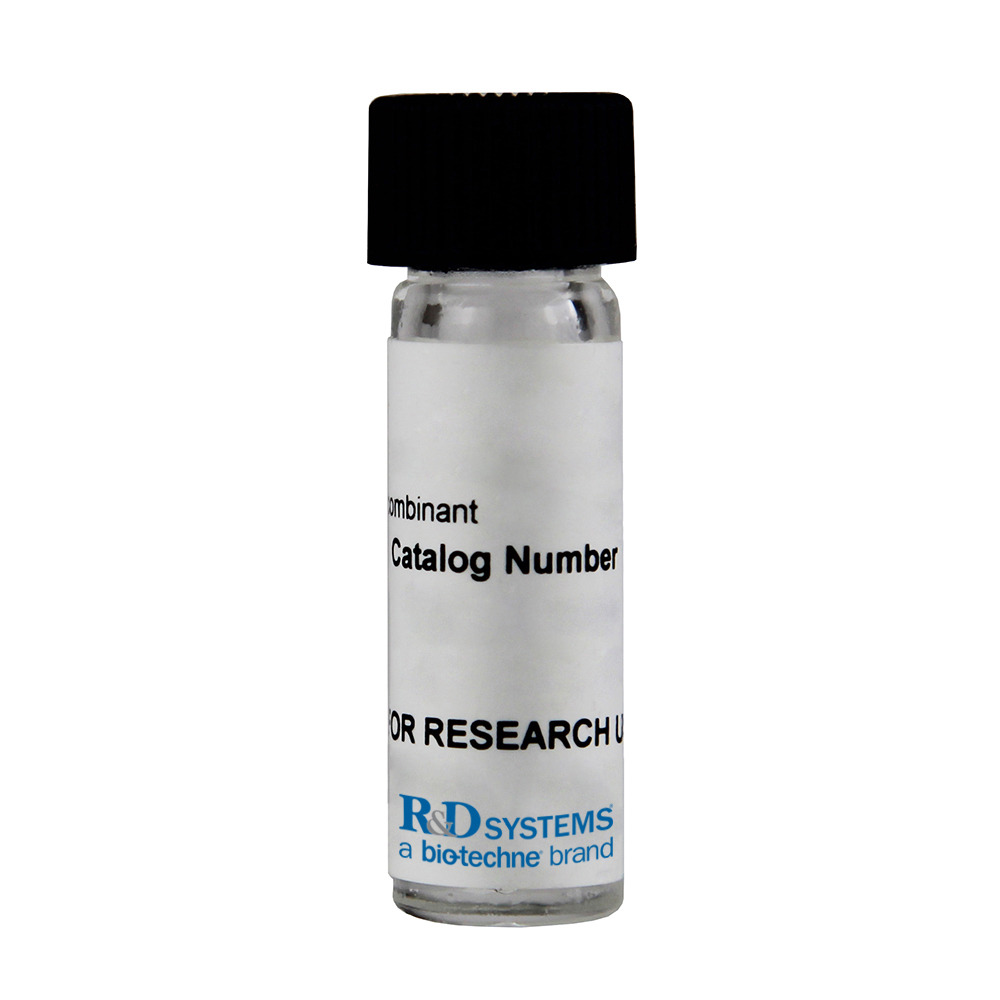 全部商品分类
全部商品分类

 下载产品说明书
下载产品说明书 下载SDS
下载SDS 用小程序,查商品更便捷
用小程序,查商品更便捷


 收藏
收藏
 对比
对比 咨询
咨询Carrier Free
CF stands for Carrier Free (CF). We typically add Bovine Serum Albumin (BSA) as a carrier protein to our recombinant proteins. Adding a carrier protein enhances protein stability, increases shelf-life, and allows the recombinant protein to be stored at a more dilute concentration. The carrier free version does not contain BSA.
In general, we advise purchasing the recombinant protein with BSA for use in cell or tissue culture, or as an ELISA standard. In contrast, the carrier free protein is recommended for applications, in which the presence of BSA could interfere.
255-SC
| Formulation | Lyophilized from a 0.2 μm filtered solution in PBS with BSA as a carrier protein. |
| Reconstitution | Reconstitute at 100-200 μg/mL in sterile PBS containing at least 0.1% human or bovine serum albumin. |
| Shipping | The product is shipped at ambient temperature. Upon receipt, store it immediately at the temperature recommended below. |
| Stability & Storage: | Use a manual defrost freezer and avoid repeated freeze-thaw cycles.
|
255-SC/CF
| Formulation | Lyophilized from a 0.2 μm filtered solution in PBS. |
| Reconstitution | Reconstitute at 100-200 μg/mL in sterile PBS. |
| Shipping | The product is shipped at ambient temperature. Upon receipt, store it immediately at the temperature recommended below. |
| Stability & Storage: | Use a manual defrost freezer and avoid repeated freeze-thaw cycles.
|
Recombinant Human SCF Protein Summary
Product Specifications
Glu26-Ala189, with an N-terminal Met
Analysis
Background: SCF/c-kit Ligand
What is Stem cell factor?
Stem cell factor (SCF) is a potent hematopoietic growth factor required in regulating both embryonic and adult hematopoiesis. SCF protein promotes the survival, differentiation, and mobilization of multiple cell types including myeloid, erythroid, megakaryocytic, lymphoid, germ cell, and melanocyte progenitors (1 7). SCF is a primary growth and activation factor for mast cells and eosinophils (8). And SCF assists in the recovery of cardiac function following myocardial infarction by increasing the number of cardiomyocytes and vascular channels (9). Stem cell factor is an important cytokine for ex vivo clinical applications. Along with other cytokines, SCF is used in the culture and expansion of hematopoietic stem cells (HSCs) as well as for proliferation and differentiation of both myeloid and erythroid progenitor cells.
Mature stem cell factor consists of a 189 amino acid (aa) extracellular domain (ECD), a 23 aa transmembrane domain, and a 36 aa cytoplasmic tail (10). The ECD shows both N linked and O-linked glycosylation (11). SCF protein exists in two forms, a membrane-bound form and a proteolytically processed soluble form that lacks the transmembrane domain and cytoplasmic tail. The soluble form is created by proteolytic cleavage at two alternate sites in the extracellular juxtamembrane region releasing a 25 kDa soluble SCF protein which is comparable to the only form produced by Steel-dickie mutant mice (12, 13). There is also an alternately spliced isoform of human SCF that lacks 28 amino acids that encompasses the primary proteolytic recognition site (14). This form cannot be cleaved and is only membrane bound.
SCF binds to C-kit (CD117). C-kit is expressed on many different cell types including HSCs, mast cells, germ cells, and melanocytes. Binding of SCF to C-kit induces receptor dimerization and autophosphorylation of tyrosine residues in the cytoplasmic domain (15). Tyrosine phosphorylation initiates multiple signaling pathways including RAS, PI3 kinase, Src, and JAK/STAT. Stem cell factor is highly conserved among mammals. Human SCF protein shares 79% 87% aa sequence identity with dog, cat, mouse, and rat SCF. Rat SCF is active on mouse and human cells, but human SCF is only weakly active on mouse cells (10).
- Ashman, L.K. (1999) Int. J. Biochem. Cell Biol. 31:1037.
- Sette, C. et al. (2000) Int. J. Dev. Biol. 44:599.
- Yoshida, H. et al. (2001) J. Invest. Dermatol. Symp. Proc. 6:1.
- Erlandsson, A. et al. (2004) Exp. Cell Res. 301:201.
- Kapur, R. et al. (2002) Blood 100:1287.
- Wang, C.-H. et al. (2007) Arterioscler. Thromb. Vasc. Biol. 27:540.
- Bashamboo, A. et al. (2006) J. Cell Sci. 119:3039.
- Reber, L. et al. (2006) Eur. J. Pharmacol. 533:327.
- Kanellakis, P. et al. (2006) Cardiovasc. Res. 70:117.
- Martin, F.H. et al. (1990) Cell 63:203.
- Arakawa, T. et al. (1991) J. Biol. Chem. 266:18942.
- Majumdar, M.K. et al. (1994) J. Biol. Chem. 269:1237.
- Brannan, C.I. et al. (1991) Proc. Natl. Acad. Sci. 88:4671.
- Anderson, D.M. et al. (1991) Cell Growth Differ. 2:373.
- Lemmon, M.A. et al. (1997) J. Biol. Chem. 272:6311.


参考图片
Recombinant Human SCF/c-kit Ligand (Catalog # 255-SC) stimulates cell proliferation of the TF-1 human erythroleukemic cell line. The ED50 for this effect is typically 1-5 ng/mL.
1 μg/lane of Recombinant Human SCF/c-kit Ligand was resolved with SDS-PAGE under reducing (R) conditions and visualized by silver staining, showing a single band at 19 kDa.




